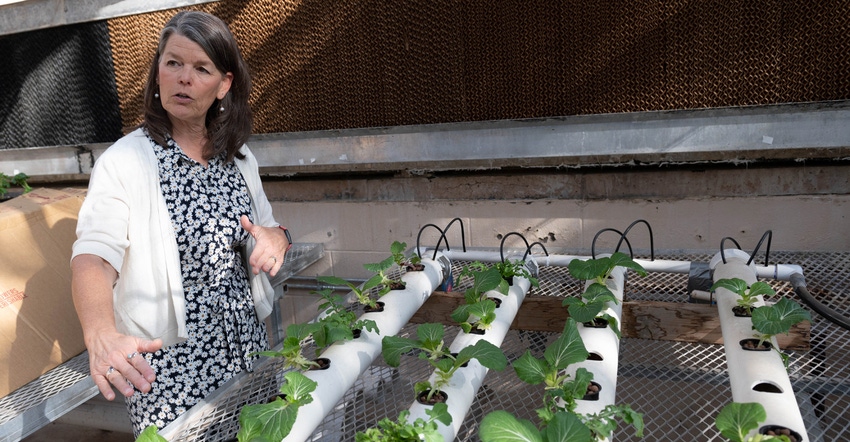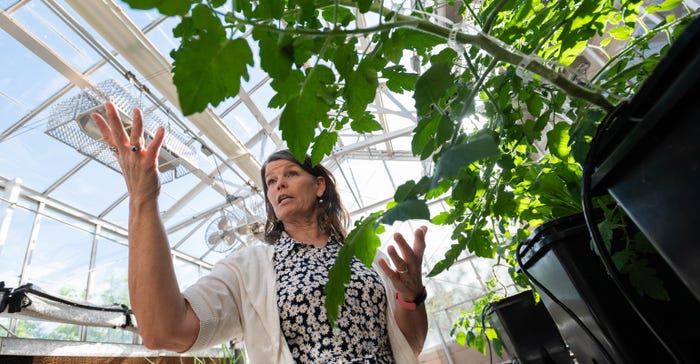April 29, 2022

Mireya Ferran didn’t have much experience using hydroponic systems to grow plants until she stepped into Rachel Gioannini’s greenhouse at New Mexico State University.
In the greenhouse, undergraduate students like Ferran use their hands and minds to practice the concepts of growing crops without soil as part of Gioannini’s hydroponics course.
Gioannini, a college assistant professor of horticulture in NMSU’s Department of Plant and Environmental Sciences, developed the course in 2020 to introduce students to the basics of soil-less growing systems. It is the only class offered at NMSU dedicated to hydroponics, which uses water-based, nutrient-rich solutions to cultivate plants without soil.
Ferran, a freshman horticulture major, saw the course as an opportunity to learn about a novel growing method and jumped at the chance to take it this spring. She has since learned how to build different types of hydroponic systems out of inexpensive materials such as plastic buckets and tubing and grow a variety of plants with much success.

Rachel Gioannini, college assistant professor of horticulture at New Mexico State University, points to the roots of a plant grown in a nutrient film technique hydroponics system – one of four systems Gioannini uses in her hydroponics course. (NMSU photos by Josh Bachman)
Today, the greenhouse outside Skeen Hall is lush with a mix of leafy greens and fruiting crops like bok choy, spinach, arugula, basil, sage, dill, thyme, tomatoes, tomatillos, jalapeños and peppers – all grown by Ferran and her classmates.
“It’s the perfect mix of agricultural knowledge and hands-on learning,” Ferran said.
The course is a natural fit for Gioannini, a former landscape designer and theater stage manager who now teaches horticulture and landscape design classes in NMSU’s College of Agricultural, Consumer and Environmental Sciences.
“I’m pretty passionate about feeding our ever-growing population and caring for the Earth,” she said. “I’m equally passionate about what the outdoors should mean to people and why we should care for it.”
Gioannini said the idea for the course came from students she met while interviewing for her teaching position at NMSU. The group had expressed interest in learning about hydroponics as an alternative crop-growing system.
Deep dive
After joining NMSU in 2018, Gioannini began a deep dive into the world of hydroponics that included reaching out to various experts for advice and completing at least one rigorous class at the University of Arizona – all of which helped in developing her course.
Gioannini’s course, first offered in fall 2020, covers the most widely used soil-less growing systems through classroom lectures and practical experience in her greenhouse.
“I’m hoping students leave with a holistic approach of how to do hydroponics,” she said.
This semester, students in the course worked with four systems, including aeroponics, Dutch buckets, tower and nutrient film technique, or NFT.
Working in groups of five, the class of 20 rotated through the four units every three weeks and evaluated their benefits and constraints. Each student also maintained an individual hydroponic system in a Mason jar.
Gioannini said she encourages her students to experiment freely and think outside the box.
“If they want to try something, I’ll tell them to go for it,” she said. “Sometimes, we get really creative solutions.”
Ferran said she appreciated the freedom to test different techniques and theories.
“It involved creative and engineering aspects, so we had to be resourceful,” she said. “Just being able to use your own materials and what you have on hand to put together something that functions and can eventually create something harvestable was immensely enjoyable.”
Student feedback
Matias Lujan, a sophomore studying horticulture, also gave the course high marks.
“It’s been extremely fun, and I’ve learned so much,” he said.

Rachel Gioannini, college assistant professor of horticulture at New Mexico State University, shows off a tomato plant grown by students in her hydroponics course. Gioannini developed the course in 2020 to introduce students to soil-less growing systems.
Lujan said he took the course because he’s interested in a career in hydroponics. He particularly enjoyed working with the different systems.
“We’ve been able to work with four major systems and their components and spent time learning how to operate them and the whole nine yards,” he said.
Both Lujan and Ferran praised Gioannini and her teaching approach.
“Rachel is a wonderful professor, and I knew that if I took a class with her, it would probably be very beneficial, and I would enjoy it – and all that’s been true,” Ferran said.
Lujan added: “Rachel is a really great teacher who loves working with students.”
Gioannini will wrap up the spring course next week and plans to offer it again in spring 2024. By that time, she hopes to have formed collaborations with other campus organizations that can make good use of the produce grown by students.
In the spring of 2023, she will offer a new course in sustainable food production trends.
“For all of my classes, I want to teach people to be a little more observant and get away from this particular thing,” she said, pointing to her phone, “and to look out and see what’s there. I want to spark people’s curiosity to discover new sustainable ways of doing things.”
Source: is NMSU, which is solely responsible for the information provided and is wholly owned by the source. Informa Business Media and all its subsidiaries are not responsible for any of the content contained in this information asset.
You May Also Like




